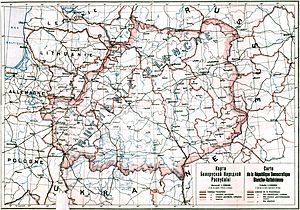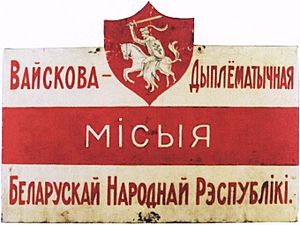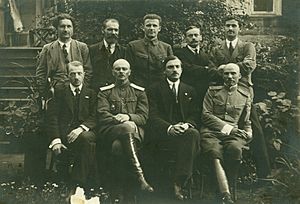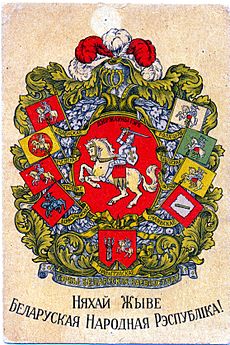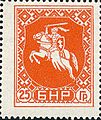Belarusian Democratic Republic facts for kids
Quick facts for kids
Belarusian Democratic Republic
Беларуская Народная Рэспубліка
Bielaruskaja Narodnaja Respublika |
|||||||||||||||
|---|---|---|---|---|---|---|---|---|---|---|---|---|---|---|---|
| 1918–1919 Exile: 1919–present |
|||||||||||||||
|
|
|||||||||||||||
|
Anthem: "Ваяцкі марш"
"March of the Warriors" |
|||||||||||||||
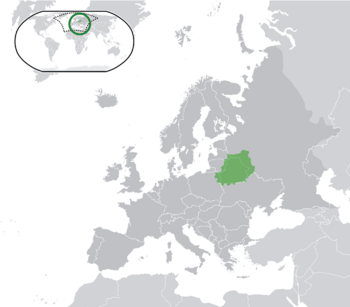
Claimed territories
|
|||||||||||||||
| Status | Partially-recognized state under German occupation (1918) Government in exile (since 1918) |
||||||||||||||
| Capital | 1918 Minsk · Vilnius 1918–1919 Grodno |
||||||||||||||
| Capital-in-exile | 1919–1923 Kaunas 1923–1945 Prague 1948–1970 Paris 1970–1983 Toronto 1983–present Ottawa |
||||||||||||||
| Common languages | Belarusian Minority languages: Russian Polish Yiddish Lithuanian Ukrainian |
||||||||||||||
| Demonym(s) | Belarusian | ||||||||||||||
| Government | Republic under a provisional government | ||||||||||||||
| President of the Rada |
|||||||||||||||
|
• 1918
|
Jan Sierada | ||||||||||||||
|
• 1918–1919
|
Jazep Losik (acting) | ||||||||||||||
| President in exile | |||||||||||||||
|
• 1919–1928
|
Piotra Krečeŭski | ||||||||||||||
|
• 1928–1943
|
Vasil Zacharka | ||||||||||||||
|
• 1944–1970
|
Mikoła Abramčyk | ||||||||||||||
|
• 1970–1982
|
Vincent Žuk-Hryškievič | ||||||||||||||
|
• 1982–1997
|
Jazep Sažyč | ||||||||||||||
|
• 1997–present
|
Ivonka Survilla | ||||||||||||||
| Legislature | Rada | ||||||||||||||
| Historical era | World War I | ||||||||||||||
|
• Established
|
6 March 1918 | ||||||||||||||
|
• Independence proclaimed
|
25 March 1918 | ||||||||||||||
|
• Disestablished
|
Spring 1919 | ||||||||||||||
|
• In exile
|
1919–present | ||||||||||||||
| Currency | Ruble | ||||||||||||||
|
|||||||||||||||
The Belarusian People's Republic (BNR), also known as the Belarusian Democratic Republic, was a state declared during World War I. Its leaders announced its creation on March 9, 1918. They then declared it fully independent on March 25, 1918, while German forces occupied Belarus.
The BNR government never fully controlled all of Belarus. In 1919, it shared power with a Soviet-controlled government. The BNR government moved its capital to Vilnius and Grodno. However, it stopped existing when Belarus was divided between the Soviet Red Army and Polish forces after the Polish–Soviet War (1919–1921).
Today, the BNR's government continues to exist in exile. It is called the Rada (Council) of the Belarusian Democratic Republic. It is the oldest government in exile still active.
Contents
What's in a Name?
The Belarusian People's Republic is known by a few names. Sometimes it was called the White Ruthenian Democratic Republic. Today, the names Belarusian Democratic Republic and Belarusian National Republic are most common.
The current government-in-exile, the Rada BNR, uses the name Belarusian Democratic Republic. You can also find this name in books and articles from Belarus. The name Belarusian People's Republic is also used, but less often.
History of the BNR
After the February Revolution in Russia in 1917, people in Belarus began discussing their future. They wondered if they should become a self-governing region within Russia or declare full independence.
Many leaders from different groups formed the Belarusian National Council in late 1917. This Council started to set up government offices for Belarus. Both the German and Bolshevik (Russian communist) forces did not recognize this new council. They also tried to stop its work.
However, Germany saw an independent Belarus as part of their plan for new states in Central Europe. The Bolsheviks even talked about recognizing the BNR. But they later decided to create their own pro-Soviet government in Belarus instead. This became the Soviet Socialist Republic of Belarus.
On February 21, 1918, the German army took control of Minsk. On the same day, the Belarusian Council declared itself the only rightful power in Belarus. But neither the German army nor the German government in Berlin were interested in an independent Belarusian state.
On March 3, Germany and the Bolsheviks signed the Treaty of Brest-Litovsk. This treaty ended Russia's involvement in World War I. On March 6, the Belarusian Council announced the creation of the Belarusian People's Republic. The Council became the temporary government and was renamed the Council of the Belarusian People's Republic.
Finally, on March 25, 1918, the All-Belarusian Congress officially declared the independence of the Belarusian National Republic (BNR). In December 1918, the BNR government left Minsk. It moved to Lithuania and then went into exile in the spring of 1919.
Claimed Territory
In its declaration of independence, the BNR claimed several regions. These included the Mogilev province and parts of the Minsk, Grodno, Vilna, Vitebsk, and Smolensk provinces. They also claimed other areas where Belarusians lived.
These areas were chosen because most people there were Belarusian, or there was a large Belarusian population. Many Lithuanians, Poles, and Jews also lived in these regions.
Military Efforts
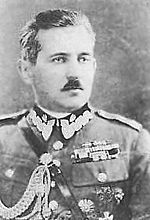
The new Belarusian People's Republic tried to create its own army. Belarusian military groups began forming in 1917 from the old Russian army.
Historians believe about 11,000 volunteers served in the BNR Army. General Stanisław Bułak-Bałachowicz supported the BNR government. He saw his army as a Belarusian national army.
A major military action of the BNR Army was the Slutsk defence action in late 1920. The BNR Council, then in Lithuania, sent officers to help organize resistance against the Bolsheviks in the town of Slutsk.
Foreign Relations
The BNR government worked closely with the Ukrainian People's Republic. They arranged for food supplies from Ukraine to Belarus, which helped prevent hunger.
In 1918, Anton Łuckievič, the prime minister of Belarus, met with Vladimir Lenin. He hoped to get Soviet Russia to recognize Belarus's independence. The Belarusian group even suggested forming a partnership with Russia. They also offered to adopt the Soviet Constitution in Belarus. But Lenin did not agree.
In 1919, a BNR group led by Prime Minister Łuckievič went to the Paris Peace Conference, 1919. They tried to get other countries to recognize Belarus as an independent nation. On their way, they met with Czechoslovak president Tomáš Masaryk in Prague.
In October 1919, Estonia officially recognized the Belarusian People's Republic. Finland followed in December 1919. On November 11, 1920, the BNR signed a treaty with Lithuania. Both countries agreed to recognize and work with each other.
Other Actions
The BNR government also helped create between 150 and 350 schools. They also started planning for a university in Minsk.
Government in Exile
In December 1918, the German army left Belarus. The Red Army then moved in and set up the Socialist Soviet Republic of Belarus. The Rada (Council) of the BNR moved to Grodno. This city was the center of a partly self-governing Belarusian area within Lithuania.
During the Polish-Soviet War (1919–1920), the Rada went into exile. From exile, it supported efforts against communism in Belarus during the 1920s.
In 1925, the exiled Rada of the BNR considered giving up its power. They thought about handing it over to the Belarusian Soviet Socialist Republic, which controlled eastern Belarus. However, this idea was not approved.
During World War II, the Belarusian government-in-exile was based in Prague. It refused to work with Nazi Germany or with the pro-German government in Belarus. Instead, it supported the Western Allies.
When the Red Army advanced in 1945, the BNR's Rada had to move to western Germany. This area was occupied by British and American troops. In February 1948, the Rada announced it was back in action. In April 1948, the Rada held a meeting in Osterhofen, Bavaria.
After the dissolution of the Soviet Union in the 1990s, other governments-in-exile, like those of Lithuania and Poland, gave their power back to their newly independent countries.
When the Belarusian Soviet Socialist Republic declared independence in 1990, the Rada said it was ready to give its power to a democratically elected parliament in Belarus. However, these plans changed after Alexander Lukashenko became president in 1994. His government limited freedoms and brought back some Soviet-era policies.
The Rada BNR still exists as a government in exile. It works to represent the interests of Belarusians living outside Belarus.
Since the late 1980s, March 25 is widely celebrated as Freedom Day (Belarusian: Дзень волі) by those who support democracy in Belarus. This day often includes large gatherings in Minsk and celebrations by Belarusian groups around the world.
Symbols
The BNR adopted a national flag with three stripes: white-red-white. It also chose a state seal called Pahonia. This symbol was based on an emblem from the Grand Duchy of Lithuania.
Presidents of the Rada
These are the leaders of the Council of the Belarusian People's Republic:
- Jan Sierada (1918)
- Jazep Losik (1918–1919; acting leader)
- Piotra Krečeŭski (1919–1928)
- Vasil Zacharka (1928–1943)
- Mikoła Abramčyk (1944–1970)
- Vincent Žuk-Hryškievič (1970–1980)
- Jazep Sažyč (1980–1997)
- Ivonka Survilla (1997–present)
Archives
In 1998, a Belarusian linguist named Siarhiej Šupa published two large books of BNR documents. These books contain over 1700 pages. They are mostly organized documents from a Lithuanian archive. These documents make up about 60% of all official BNR papers from 1918. Another 20% are in archives in Minsk, while the rest are missing.
See also
 In Spanish: República Popular Bielorrusa para niños
In Spanish: República Popular Bielorrusa para niños
- Freedom Day (Belarus)
- Ukrainian People's Republic




